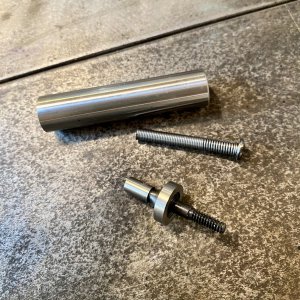-
Welcome back Guest! Did you know you can mentor other members here at H-M? If not, please check out our Relaunch of Hobby Machinist Mentoring Program!
You are using an out of date browser. It may not display this or other websites correctly.
You should upgrade or use an alternative browser.
You should upgrade or use an alternative browser.
Reassembling an Edge Finder?
- Thread starter JRT
- Start date
- Joined
- Feb 1, 2015
- Messages
- 9,622
I have repaired/reassembled several edge finders. In fact, the one I use the most has a cracked shank from a run-in wit an immovable object. I piece the two halve together and mount it in a 1/2" end mill holder.. It works like new and is my most sensitive edge finder which is why use it most.
I believe that your tip screws into the spring. You will have to insert the spring into the shank and stretch it so it protrudes out the other end. There are several ways to do this and perhaps the easiest is to use a long screw with a diameter and pitch close to that of the tip[. Screw the long screw into the spring and insert the screw and sp[ring into the shank. Grab the screw and use it to stretch the spring. Slide a thin shim into the coils to retain the extended spring and unscrew the screw and replace it with the tip. You don't want the tip to be too loose or too tight. Too loose and the tip will flop around. Too tight and the sensitivity drops. It may take some experimentation to hit the sweet spot.
I believe that your tip screws into the spring. You will have to insert the spring into the shank and stretch it so it protrudes out the other end. There are several ways to do this and perhaps the easiest is to use a long screw with a diameter and pitch close to that of the tip[. Screw the long screw into the spring and insert the screw and sp[ring into the shank. Grab the screw and use it to stretch the spring. Slide a thin shim into the coils to retain the extended spring and unscrew the screw and replace it with the tip. You don't want the tip to be too loose or too tight. Too loose and the tip will flop around. Too tight and the sensitivity drops. It may take some experimentation to hit the sweet spot.
- Joined
- Feb 1, 2015
- Messages
- 9,622
Tom Lipton, aka Oxtoolco, also made a custom edgefinder. His method is a bit beyond the capability of most hobby shops but interesting to watch.
A few considerations for those attempting to make their own edgefinder. The contact edge should be perfectly round and to be most useful, it should be some nice even diameter; e.g. .5000", 10.00mm, etc.. The interface between the shank and the tip should be perfectly perpendicular to the contact edge. Otherwise there will be a wobble in the contact surface which will potentially give rise to variability in the contact point and/or errors in the applied offset. If post hardening as Joe Pieczynski suggest, keep in mind the the hardening process can create a warping situation so all your careful machining done beforehand can go out the window. Best practice would dictate that final machining be done post hardening.
A few considerations for those attempting to make their own edgefinder. The contact edge should be perfectly round and to be most useful, it should be some nice even diameter; e.g. .5000", 10.00mm, etc.. The interface between the shank and the tip should be perfectly perpendicular to the contact edge. Otherwise there will be a wobble in the contact surface which will potentially give rise to variability in the contact point and/or errors in the applied offset. If post hardening as Joe Pieczynski suggest, keep in mind the the hardening process can create a warping situation so all your careful machining done beforehand can go out the window. Best practice would dictate that final machining be done post hardening.


